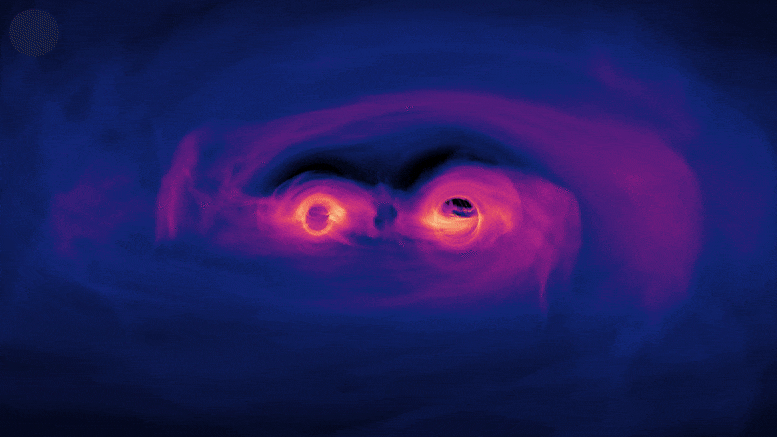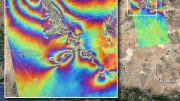
A simulation of colliding supermassive binary black holes. Credit: NASA
Galaxies host supermassive black holes, which weigh millions to billions of times more than our Sun. When galaxies collide, pairs of supermassive black holes at their centers also lie on the collision course. It may take millions of years before two black holes slam into each other. When the distance between them is small enough, the black hole binary starts to produce ripples in space-time, which are called gravitational waves.
Gravitational waves were first observed in 2015, but they were detected from much smaller black holes, which weigh about tens times our Sun. Gravitational waves from supermassive black holes are still a mystery to scientists. Their discovery would be invaluable to figuring out how galaxies and stars form and evolve, and finding the origin of dark matter.
A recent study led by Dr. Boris Goncharov and Prof Ryan Shannon—both researchers from the ARC Centre of Excellence for Gravitational Wave Discovery (OzGrav)—has tried to solve this puzzle. Using the most recent data from the Australian experiment known as the Parkes Pulsar Timing Array, the team of scientists searched for these mystery gravitational waves from supermassive black holes.
The experiment observed radio pulsars: extremely dense collapsed cores of massive supergiant stars (called neutron stars) that pulse out radio waves, like a lighthouse beam. The timing of these pulses is extremely precise, whereas the background of gravitational waves advances and delays pulse arrival times in a predicted pattern across the sky, by around the same amount in all pulsars.
The researchers now found that arrival times of these radio waves do show deviations with similar properties as we expect from gravitational waves However, more data is needed to conclude whether radio wave arrival times are correlated in all pulsars across the sky, which is considered the “smoking gun.” Similar results have also been obtained by collaborations based in North America and Europe. These collaborations, along with groups based in India, China, and South Africa, are actively combining datasets under the International Pulsar Timing Array, to improve the sky coverage.
This discovery is considered a precursor to the detection of gravitational waves from supermassive black holes. However, Dr. Goncharov and colleagues pointed out that the observed variations in the radio wave arrival times might also be due to pulsar-intrinsic noise. Dr. Goncharov said: “To find out if the observed “common” drift has a gravitational wave origin, or if the gravitational-wave signal is deeper in the noise, we must continue working with new data from a growing number of pulsar timing arrays across the world.”
Reference: “On the Evidence for a Common-spectrum Process in the Search for the Nanohertz Gravitational-wave Background with the Parkes Pulsar Timing Array” by Boris Goncharov, R. M. Shannon, D. J. Reardon, G. Hobbs, A. Zic, M. Bailes, M. Curylo, S. Dai, M. Kerr, M. E. Lower, R. N. Manchester, R. Mandow, H. Middleton,, M. T. Miles, A. Parthasarathy, E. Thrane, N. Thyagarajan, X. Xue, X.-J. Zhu, A. D. Cameron, Y. Feng, R. Luo, C. J. Russell, J. Sarkissian, R. Spiewak, S. Wang, J. B. Wang, L. Zhang and S. Zhang, 17 August 2021, The Astrophysical Journal Letters.
DOI: 10.3847/2041-8213/ac17f4









Colliding supermassive Black Holes aren’t the only thing that cause huge gravitational waves.
While everyone is focused on supermassive Black Holes at the centers of galaxies, another possibility exists. According to String Theory, a brane (dimensional membrane) surrounds our universe. What if such branes, rather than Black Holes, are also the centers of galaxies? Superheated gas would also form around branes, and they would explain how the matter in the universe became concentrated as galaxies even as the universe was, and still is, flying apart from the Big Bang at a rate that absolutely won’t allow any matter (quarks, even) to gravitationally attract each other to form anything. It would also explain those low-mass stars at the center of the Milky Way and the Andromeda galaxy, and other curious phenomena seen at those centers. How would we know if the center is a Black Hole or a brane? If material (gas, etc.) is seen swirling into the center, it’s a Black Hole. If material doesn’t swirl in, that would be support for a brane. The physical creation of brane-centered galaxies using the quantum foam and similar to Hawking radiation can be described in my YouTube https://www.youtube.com/watch?v=IaxfuKXdhkg
The deviation of pulsar wave than gravitational wave SMBH differ for galaxies.Thus speed òf light is different in different in galaxies.This is basic proporty of super massive black hoĺe singularity in galaxy and no root to be a constant except to the milkyway.
Ozgrav: did you actually use the filler word ‘like’ in a published article? (Second paragraph, first sentence). I, like, totally stopped reading right then, bro.
Thanks for the feedback. This has been fixed.
This phenomena states that-
1.The effect of gravity changes in small scaĺe with time.
2.Gaĺaxies move relative to each other ìn nonlinear way.So changge in gravity is not smooth but has a gradient.
3.Galaxies have accleration in expansion rate.This has proportional change in stars through SMBH.
This phenomena states that-
1.The effect of gravity changes in small scaĺe with time.
2.Gaĺaxies move relative to each other ìn nonlinear way.So changge in gravity is not smooth but has a gradient.
3.Galaxies have accleration in expansion rate.This has proportional change in stars through SMBH.
Thus,the time difference between gravitational wave fròm SMBH and radio waves of pulsars,for respective galaxies can be confirmed.Time difference value from galaxy to galaxy can change.
Thanķs to the Authors.